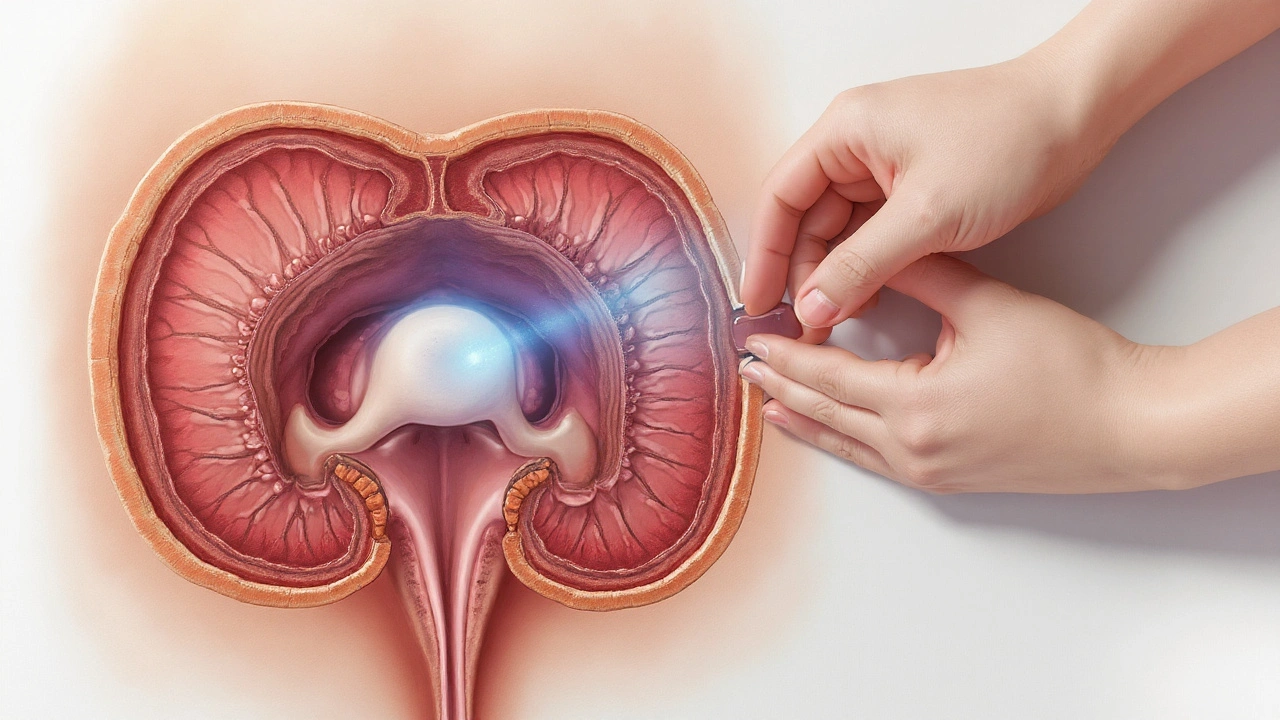Saw Palmetto is a berry extract from the Serenoa repens palm that contains high levels of phytosterols, especially beta‑sitosterol. These compounds act as natural 5‑alpha‑reductase inhibitors, which means they can lower dihydrotestosterone (DHT) production and support several aspects of male wellness.
Why Saw Palmetto is Gaining Attention
People often turn to prescription drugs for prostate enlargement or hair loss, but many are looking for a gentler, plant‑based option. Saw Palmetto offers a blend of anti‑inflammatory and hormone‑balancing effects without the harsh side‑effects that can come with synthetic medicines. In the past decade, sales of the Saw Palmetto supplement have risen sharply, reflecting growing trust in its safety profile and real‑world results.
How It Works: The Core Mechanism
At the heart of Saw Palmetto’s benefits is its impact on Dihydrotestosterone (DHT). DHT is a potent androgen created when the enzyme 5‑alpha‑reductase converts testosterone. Elevated DHT levels are linked to prostate enlargement, scalp hair miniaturization, and increased urinary resistance. The phytosterols in Saw Palmetto bind to the enzyme’s active site, reducing its activity by up to 30% in laboratory settings. The downstream effect is a modest drop in circulating DHT, which helps keep the prostate size in check and slows hair follicle shrinkage.
Key Health Benefits
- Prostate Health: Clinical trials have shown that men taking 320mg of standardized extract daily experience a 20‑30% reduction in nighttime urination frequency.
- Hair Loss Prevention: By lowering DHT at the scalp, Saw Palmetto can slow the progression of androgenic alopecia, especially when combined with biotin and zinc.
- Urinary Function: Improved flow rates and decreased residual urine volume are commonly reported after eight weeks of consistent use.
- Inflammation Reduction: The extract’s beta‑sitosterol and fatty acid profile dampen pro‑inflammatory cytokines, supporting overall hormonal balance.
Scientific Evidence
Several peer‑reviewed studies provide a solid foundation for Saw Palmetto’s claims. A 2016 double‑blind trial involving 156 men with benign prostatic hyperplasia (BPH) found that 320mg of standardized extract reduced International Prostate Symptom Score (IPSS) by an average of 4.5 points versus placebo. Another 2019 meta‑analysis of 21 randomized controlled trials concluded that Saw Palmetto performed comparably to the prescription drug finasteride for mild to moderate BPH symptoms, with a markedly better side‑effect profile.
For hair loss, a 2020 open‑label study of 70 males reported a 12% increase in hair density after six months of combined Saw Palmetto (160mg twice daily) and minoxidil. Although more large‑scale trials are needed, the trend is promising.
Choosing a Quality Product
Not all Saw Palmetto supplements are created equal. Look for these attributes:
- Standardization: Products should guarantee at least 45% fatty acids and 0.2% beta‑sitosterol.
- Extraction Method: CO₂ or ethanol extraction preserves active constituents better than water‑based processes.
- Third‑Party Testing: Independent labs confirm potency and purity, flagging heavy‑metal contaminants.
- Formulation: Capsules, softgels, and liquid tinctures are common. Capsules provide consistent dosing; tinctures may be easier for those with swallowing difficulties.
When in doubt, check the label for a Certificate of Analysis (CoA) and verify that the manufacturer follows Good Manufacturing Practices (GMP).

Recommended Dosage and Safety
Most research uses 320mg per day of a standardized extract, split into two 160mg doses with meals. Starting with a lower dose (e.g., 80mg) can help the body adjust, especially for newcomers.
Side effects are rare but may include mild stomach upset or headache. Saw Palmetto can interact with blood‑thinning medications (e.g., warfarin) and hormonal therapies, so consulting a healthcare professional is wise if you’re on prescription drugs.
Comparison with Other Options
| Attribute | Saw Palmetto | Finasteride (Prescription) | Pumpkin Seed Oil |
|---|---|---|---|
| Primary Action | Natural 5‑α‑reductase inhibition | Synthetic 5‑α‑reductase inhibition (high potency) | Phytosterol‑rich, mild enzyme inhibition |
| Typical Dose | 320mg daily (standardized) | 1mg daily | 1000mg daily (oil) |
| Prostate Symptom Relief | 20‑30% improvement (studies) | 30‑45% improvement | 10‑15% improvement |
| Hair Loss Impact | Modest (12% density rise in 6mo) | Strong (often >20% density rise) | Minor (5‑8% density rise) |
| Side‑Effect Frequency | Low (≤5% mild GI) | Higher (sexual dysfunction 8‑12%) | Very low (≤2% GI) |
The table shows that while finasteride delivers the strongest symptom relief, Saw Palmetto offers a balance of efficacy and tolerability. Pumpkin Seed Oil is a gentler alternative but may require higher doses for comparable results.
Related Topics to Explore
Understanding Saw Palmetto’s role fits into a larger wellness picture. You may also want to read about:
- Zinc - a mineral that supports testosterone metabolism and can boost the effects of DHT‑lowering herbs.
- Vitamin D - deficiency is linked to BPH progression; supplementation may complement Saw Palmetto.
- Dietary patterns that reduce chronic inflammation, such as the Mediterranean diet.
- Exercise regimens that improve urinary flow and hormonal balance.
These topics form a natural next step for anyone building a comprehensive prostate‑friendly lifestyle.
Putting It All Together
When you decide to add Saw Palmetto to your daily routine, treat it as a piece of a broader health strategy. Pair the supplement with a balanced diet, regular movement, and routine check‑ups. Monitor your symptoms-whether it’s nighttime trips to the bathroom or shedding hair-and adjust the dose in consultation with a clinician.
Remember that individual responses vary. Some men notice relief within a month, while others may take three to six months to feel the full effect. Patience and consistency are key.
Frequently Asked Questions
Can women take Saw Palmetto?
Women can use Saw Palmetto, but the primary benefits-prostate support and DHT reduction-are less relevant. Some women use it for hormonal acne or hair thinning, though evidence is limited. Always check with a healthcare provider before starting.
How long does it take to see results?
Most studies report noticeable improvement in urinary symptoms after 8‑12 weeks. Hair density changes often require 4‑6 months of consistent dosing.
What is the best form-capsule or liquid?
Capsules provide exact dosing and are the most common format for clinical trials. Liquid tinctures can be useful for those with swallowing issues, but dosing may be less precise unless measured with a dropper.
Are there any interactions with medications?
Saw Palmetto may enhance the effects of blood‑thinners (e.g., warfarin) and can theoretically interfere with hormone therapies. If you take prescription drugs, discuss supplementation with your doctor.
What dosage is considered safe?
A daily intake of 320mg of standardized extract is widely regarded as safe for most adults. Starting at 80mg and gradually increasing can help minimize any mild GI upset.
How does Saw Palmetto compare to prescription drugs?
Prescription 5‑α‑reductase inhibitors (like finasteride) usually provide stronger symptom relief but carry a higher risk of sexual side‑effects. Saw Palmetto offers moderate relief with a much lower side‑effect incidence, making it attractive for men who prefer a natural approach.
Is there any evidence that Saw Palmetto prevents prostate cancer?
Current research does not support a direct cancer‑preventive effect. However, by reducing inflammation and hormonal imbalances, Saw Palmetto may contribute to overall prostate health. Regular screening remains essential.

All Comments
juliephone bee September 23, 2025
i’ve been taking saw palmetto for 5 months now and honestly? my nighttime pee trips dropped from 4 to 1. no crazy side effects, just quiet improvement. i’m not a fan of pills, but this one’s worth it.
Ellen Richards September 24, 2025
Ugh, another ‘natural remedy’ post. 🙄 Let’s be real-this is just expensive herbal tea with a fancy label. If you want real results, take finasteride. Saw palmetto is what people take when they’re too scared to face science. #WokeSupplements
Renee Zalusky September 25, 2025
Interesting how the science here is quietly revolutionary-no screaming headlines, no corporate ads. Just quiet, peer-reviewed data showing a plant can gently nudge our biology back into balance. 🌿 I love that we’re finally seeing the value in ‘slow medicine.’ Also, typo: ‘beta-sitosterol’ is spelled right, but I swear I saw ‘beta-sitostrol’ on a label last week… oops. 😅
Scott Mcdonald September 26, 2025
Hey, I tried this after my urologist said I had mild BPH. Didn’t work for me at all. I still wake up 3x a night. Maybe it’s just my body? Anyone else feel like it’s a placebo?
Victoria Bronfman September 26, 2025
OMG I JUST STARTED THIS!! 🌱💖 and guess what? I can actually sleep through the night now!! Like, no alarms, no bathroom runs, just peace. Also, my hair feels thicker?? I’m obsessed. #SawPalmettoMagic #NoMorePills
Gregg Deboben September 28, 2025
USA made this berry work for centuries before the pharma giants tried to sell us pills. You think Big Pharma wants you to know this? NO. They want you hooked on $200/month prescriptions. Saw Palmetto is American resilience in a capsule. 🇺🇸💪
Christopher John Schell September 30, 2025
YOU GOT THIS!! 🎯 Consistency is everything. I started at 80mg, worked up to 320mg, and now I’m running 5Ks like it’s nothing. Your body’s not broken-it’s just waiting for the right nudge. Keep going, brother. You’re not alone. 💪🌿
Felix Alarcón October 1, 2025
Coming from a country where herbal medicine is woven into daily life, I’ve seen this work across generations. In Mexico, saw palmetto is common in rural clinics-not as a ‘supplement,’ but as medicine. The science here aligns with tradition. I’m glad more people are listening. 🌎💚
Lori Rivera October 2, 2025
While the anecdotal evidence is compelling, the clinical data remains modest. I would caution against replacing evidence-based treatments without professional consultation. The mechanism is plausible, but individual variability is significant.
Leif Totusek October 3, 2025
Thank you for the detailed breakdown. The inclusion of the CoA and GMP standards is critical. Many consumers overlook this, assuming ‘natural’ equals safe. This level of rigor deserves recognition.